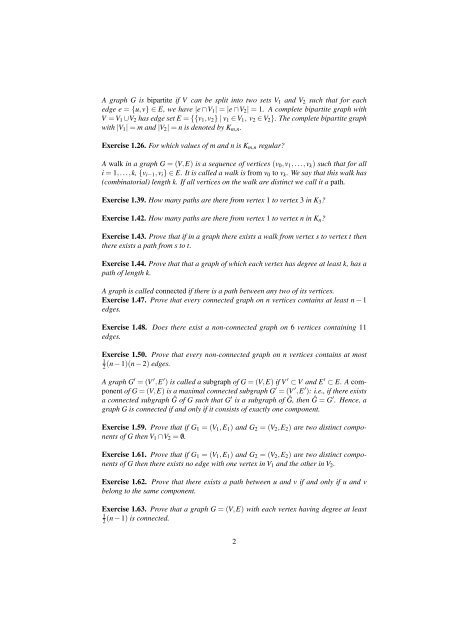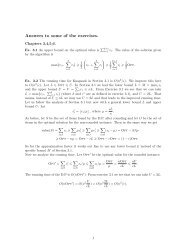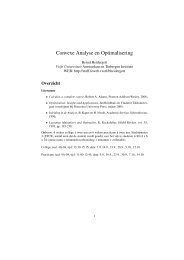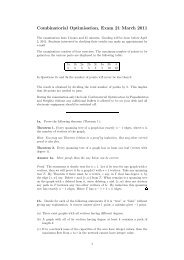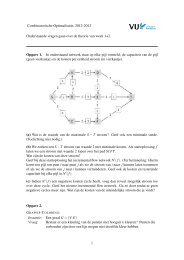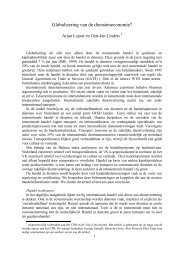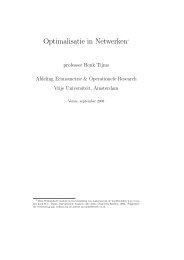Create successful ePaper yourself
Turn your PDF publications into a flip-book with our unique Google optimized e-Paper software.
A graph G is bipartite if V can be split into two sets V1 and V2 such that for each<br />
edge e = {u,v} ∈ E, we have |e ∩V1| = |e ∩V2| = 1. A complete bipartite graph with<br />
V = V1 ∪V2 has edge set E = {{v1,v2} | v1 ∈ V1, v2 ∈ V2}. The complete bipartite graph<br />
with |V1| = m and |V2| = n is denoted by Km,n.<br />
Exercise 1.26. For which values <strong>of</strong> m and n is Km,n regular?<br />
A walk in a graph G = (V,E) is a sequence <strong>of</strong> vertices (v0,v1,...,vk) such that for all<br />
i = 1,...,k, {vi−1,vi} ∈ E. It is called a walk is from v0 to vk. We say that this walk has<br />
(combinatorial) length k. If all vertices on the walk are distinct we call it a path.<br />
Exercise 1.39. How many paths are there from vertex 1 to vertex 3 in K3?<br />
Exercise 1.42. How many paths are there from vertex 1 to vertex n in Kn?<br />
Exercise 1.43. Prove that if in a graph there exists a walk from vertex s to vertex t then<br />
there exists a path from s to t.<br />
Exercise 1.44. Prove that that a graph <strong>of</strong> which each vertex has degree at least k, has a<br />
path <strong>of</strong> length k.<br />
A graph is called connected if there is a path between any two <strong>of</strong> its vertices.<br />
Exercise 1.47. Prove that every connected graph on n vertices contains at least n − 1<br />
edges.<br />
Exercise 1.48. Does there exist a non-connected graph on 6 vertices containing 11<br />
edges.<br />
Exercise 1.50. Prove that every non-connected graph on n vertices contains at most<br />
(n − 1)(n − 2) edges.<br />
1<br />
2<br />
A graph G ′ = (V ′ ,E ′ ) is called a subgraph <strong>of</strong> G = (V,E) if V ′ ⊂ V and E ′ ⊂ E. A component<br />
<strong>of</strong> G = (V,E) is a maximal connected subgraph G ′ = (V ′ ,E ′ ): i.e., if there exists<br />
a connected subgraph ˆG <strong>of</strong> G such that G ′ is a subgraph <strong>of</strong> ˆG, then ˆG = G ′ . Hence, a<br />
graph G is connected if and only if it consists <strong>of</strong> exactly one component.<br />
Exercise 1.59. Prove that if G1 = (V1,E1) and G2 = (V2,E2) are two distinct components<br />
<strong>of</strong> G then V1 ∩V2 = /0.<br />
Exercise 1.61. Prove that if G1 = (V1,E1) and G2 = (V2,E2) are two distinct components<br />
<strong>of</strong> G then there exists no edge with one vertex in V1 and the other in V2.<br />
Exercise 1.62. Prove that there exists a path between u and v if and only if u and v<br />
belong to the same component.<br />
Exercise 1.63. Prove that a graph G = (V,E) with each vertex having degree at least<br />
(n − 1) is connected.<br />
1<br />
2<br />
2


